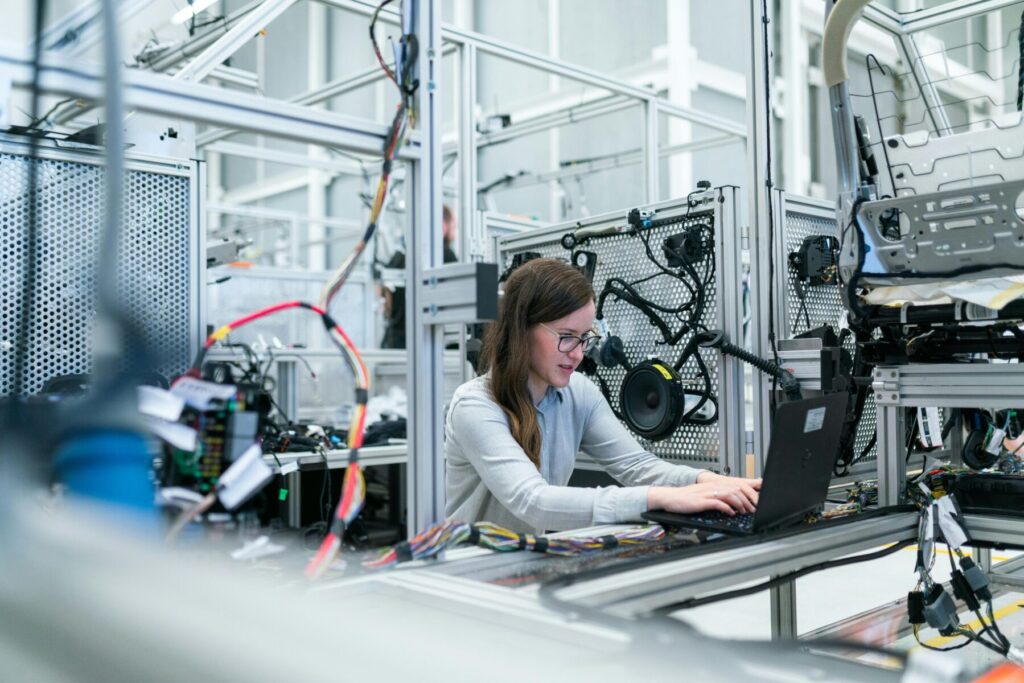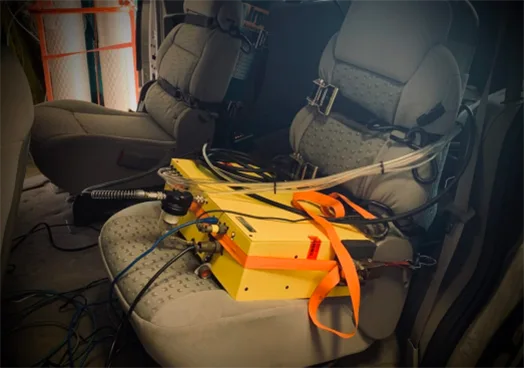
What is the meaning of NDIR? And why are non-dispersive infrared (NDIR) sensors so important for gas detection and other environmental emissions testing and regulation?
Original equipment manufacturers (OEMs) and industrial organizations: if you’ve ever wanted to improve the sustainability, productivity, and efficiency of your product, you’ll definitely want to listen to what’s coming next.
Because NDIR sensors are needed for many different industrial applications. With HVAC units, medical gear, and even vehicle emissions testing, NDIR sensors are key for ensuring a high-performing, efficient product that stays in compliance with environmental regulations.
If you’re wondering what the meaning of NDIR is, as well as how NDIR sensors can benefit you, keep reading.
In this article, you’ll learn about:
- The techniques of non-dispersive infrared
- Components used in NDIR sensors
- How CO₂ levels are calculated with NDIR
- The history of NDIR
- The materials used in making NDIR technology
- How GlobalMRV uses NDIR sensor technology to help with emissions monitoring
Non-dispersive infrared absorption (NDIR) methods

What do we mean when we say non-dispersive infrared absorption (NDIR)?
NDIR is an industry term for non-dispersive infrared, a common type of sensor that’s used to measure the amount and concentration of carbon dioxide (CO₂) in a sample.
The way the sensors work is that an infrared lamp directs waves of light through a tube filled with a sample of air. Next, the air moves toward an optical filter in front of an infrared light detector.
The infrared light detector measures the amount of infrared light that passes through the filter. As such, with an NDIR sensor, a band of infrared radiation produced by the lamp is positioned near the location where CO₂ is absorbed.
When the infrared light passes through the sample tube of air, the CO₂ gas molecules absorb the infrared light, meanwhile allowing other wavelengths to pass through without being absorbed.
At the end of the device — where the infrared detector reads the remaining amount of light that wasn’t absorbed by the CO₂ molecules or the optical filter — an analyst can read the transmitted infrared light. What’s more, the transmitted light is proportional to the concentration of CO₂ present in the sample conducted.
The mechanisms of NDIR might be multi-layered, but the principle and technology behind the technology is more straightforward.
The principle components and functions of non-dispersive infrared (NDIR) technology

So, what is the principle behind NDIR CO₂ sensors? An NDIR CO₂ sensor tends to include different components that work together to measure and provide accurate CO₂ concentrations.
The design of different NDIR sensors often vary (depending on the manufacturer), but the most common components found in an NDIR sensor include:
- An infrared light source: The NDIR sensor uses a light source that emits infrared radiation at wavelengths. The light sources provide the energy needed for the interactions with CO₂ molecules in gas samples.
- Gas sample chamber: A gas sample chamber is where the sample gas is analyzed. The chamber helps the infrared light to interact with CO₂ molecules in gas. The sample chamber is made of materials that allow infrared to pass through without being absorbed.
- Optical filters: these filters help interact with specific infrared light wavelengths that tend to be absorbed by CO₂ molecules. By using appropriate filters, the sensor can ensure certain wavelengths are detected by the detector. The filters help enhance the accuracy of each measurement.
- The sensor’s detector: The NDIR’s detector measures the amount of infrared light that passes through the gas sample after the light interacts with CO₂ molecules. The detector helps give us information about the sample’s CO₂ concentration.
- Reference channel: The reference channel helps measure the amount of infrared light that passes through a sample without being absorbed by CO₂.
- Output signals and circuits: The NDIR’s detector and reference use output signals that use integrated circuits around the sensor. The collected data from the signals and circuits include external temperature, humidity, and pressure among other data points.
NDIR, gas molecule absorption, and Beer-Lambert’s law
A helpful way to conceptualize NDIR is through a helpful law called Beer-Lambert’s law. Beer-Lambert’s law describes the relationship between the attenuation of light through a substance and the properties through which the light travels.
The Beer-Lambert Law is often expressed as: A = εLc
A is the amount of light absorbed for a wavelength by the sample. (ε) is a coefficient for the molar extinction. (L) is the distance covered by the light through a sample solution, and (c) is the concentration absorbing the light.
With that being said, infrared absorption amounts depend on the concentration of absorbing gas molecules present in the sample.
Now that we have a basic understanding of NDIR sensors and their applications, let’s take a look at how the carbon dioxide levels are calculated.
How CO₂ levels are calculated

Before discussing how CO₂ levels are calculated, worth noting is the difference between the amount of light radiated by the infrared lamp and the amount of infrared light recorded by the detector.
Why?
Because the result of the light being absorbed by the CO₂ molecules in the air inside the tube is proportional to the number of CO₂ molecules in the air sample tube.
What’s more, all measurements start out as analog micro-voltages but can then be converted into different outputs.
History of NDIR: early carbon dioxide sensor technologies

While NDIR sensors have been extremely helpful for gas analysis with 5-gas analyzers and other industrial equipment, they’re a very recent development.
Since carbon dioxide was identified in the 1700s by Joseph Black, scientists have been looking for ways to measure CO₂.
Yet, one of the first CO₂ measurement devices was the mercury manometer. A manometer uses a U-shaped glass tube filled with mercury to measure gas pressure.
While manometers are very accurate, the process of measuring CO₂ levels is time-consuming. For example, Scientist Charles Keeling was tasked with taking measurements of CO₂. Keeling instead chose to use an early infrared gas analyzer that worked with his manometer.
The result? NDIR’s early predecessors, an original infrared gas analyzer that was accurate, yet somewhat bulky.
As historical trends demonstrate, original infrared gas analyzers were used for some time. But, like Charles Keeling, engineers were looking for ways to measure CO₂ concentrations in ambient air environments — like schools, offices, automotive testing centers, and homes — and not just in environmental landscapes like the Mauna Loa volcano where Charles Keeling first used his prototype infrared gas analyzer.
So, how did we go from bulky sample tubes to the NDIR sensors and technologies we see today?
The development of small NDIR CO₂ sensors
Small NDIR CO₂ sensors became a reality when, in 1993, a small-footprint CO₂ sensor was designed. Engineers are able to measure gas samples in smaller, ambient settings, as the sensors used folded optics and metalized molded plastic to reflect light with greater efficiency.
What’s more, the reflective coating ensured CO₂ molecules inside gas sample chambers could absorb the same amount of light as the previously designed infrared gas analyzers.
This new generation of NDIR sensors used advanced optics and designs. By using advanced optics and designs, engineers can build smaller sensors that are more receptive and sensitive.
Which brings us to today’s modern NDIR CO₂ sensors
With newer, smaller, and more sensitive receptors becoming popular in the early 2000s, engineers now use CO₂ sensors that are built with more optimized shapes. The newly shaped sensors allow for longer light paths to be folded into smaller and smaller spaces.
Also, new, mid-range infrared light-emitting diode (LED) light sources are now being used. As such, new NDIR sensors can operate at much lower power levels.
With photo-diode light detectors, solid-state sensors also have a longer life span than their predecessors. Finally, the newest generation of NDIR CO₂ sensors can run for months on battery and/or solar power alone.
In other words, today’s NDIR CO₂ sensors consume much less power than traditional incandescent infrared sensors.
Materials used in making NDIR sensors

Making NDIR sensors may sound complex, but the process of creating NDIR sensors is similar to the process used to create many other handy electronics. And, with the NDIR gas sensor market projected to grow more than 7% between 2025 and 2032 (DataIntelo.com, 2025), the process of building NDIR sensors is becoming ever more important.
So, what does the process look like to create NDIR sensors?
Many automatic assembly lines using the latest in robotic technology help create NDIR sensors. Then, after being created in clean rooms, the sensors are tested and calibrated before being shipped to their destination.
Did you know?
Did you know that the NDIR sensors — used in our portable emissions measurement systems (PEMS) — take less than 3.5 seconds to record 90% of a sample gas’ CO₂ concentration? That’s right. Under four seconds: that’s how efficient NDIR sensors have become in the last century.
It’s all possible with our Axion R/S PEMS product.
Our NDIR sensor-driven PEMS devices have helped automotive companies reduce carbon dioxide, measure and verify gas samples, and reduce fleet emissions through research and development.
Here’s a detailed look at how NDIR can be applied across a variety of applications and for a variety of gases.
| Gas | Why NDIR Works Well | Typical Application |
| Carbon Dioxide (CO₂) | Strong IR absorption band | Indicator of combustion efficiency |
| Carbon Monoxide (CO) | Distinct IR absorption | Indicates incomplete combustion |
| Hydrocarbons (HC) | Many hydrocarbons absorb IR (e.g., methane and propane) | Emissions regulation and fuel leakage detection |
| Nitrous Oxide (N₂O) | Has IR-active modes | Greenhouse gas monitoring (less common in real-time PEMS) |
What’s more, certain compounds aren’t always able to be measured. As such, the UV–Visible Reflection–Absorption Spectroscopy (UVRAS) technique — or electrochemical sensors — can be used to measure and verify gas compounds.
Listed below are a few gases that can be verified using UVRAS and electrochemical sensors, along with the reasons why these sensors are necessary for verifying these gases.
| Gas | Reason |
| Nitric Oxide (NO) | Weak or no IR absorption |
| Nitrogen Dioxide (NO₂) | Weak IR absorption; better detected via UV-based methods |
| Oxygen (O₂) | IR-inactive due to symmetric molecular structure |
| Particulate Matter (PM) | Not a gas; requires optical or gravimetric methods |
Regardless of the gas type, at the end of the day, our mission is to support our partners in achieving their environmental and R&D goals. We’ve been leading a revolution in affordable, sustainable transportation and emissions monitoring for businesses and OEMs worldwide.
Interested in learning more? Check out other key ways we’re creating a greener, cleaner planet on our Instagram page.
The future of CO₂ sensors — with help from GlobalMRV

As we look towards a cleaner, greener future together, smaller, leaner, and micro CO₂ sensors will become the next innovation and continued technological advancement in emissions testing.
And when that time comes, you can bet we’ll be there leading the charge.
Our team is at the forefront of emissions testing for vehicles, power equipment, and a whole selection of other products.
Our Ph.D. researchers, managers, analysts, engineers, and technicians have run more than 60 different types of diagnostic testing regimes. We’ve also supported over 100 different vehicles and engines for overall emissions reduction and fuel calibration testing.
If you’re looking for a team well-versed in the use of NDIR sensors for vehicle calibration testing and other industrial processes, we’re here for you. For a risk-free, zero cost consultation of our portable emissions measurement devices (PEMS) that use the latest NDIR sensor technology, don’t hesitate to reach out.
We’re happy to help!
GlobalMRV – Delivering World-Class Emissions Testing Equipment and NDIR Sensors